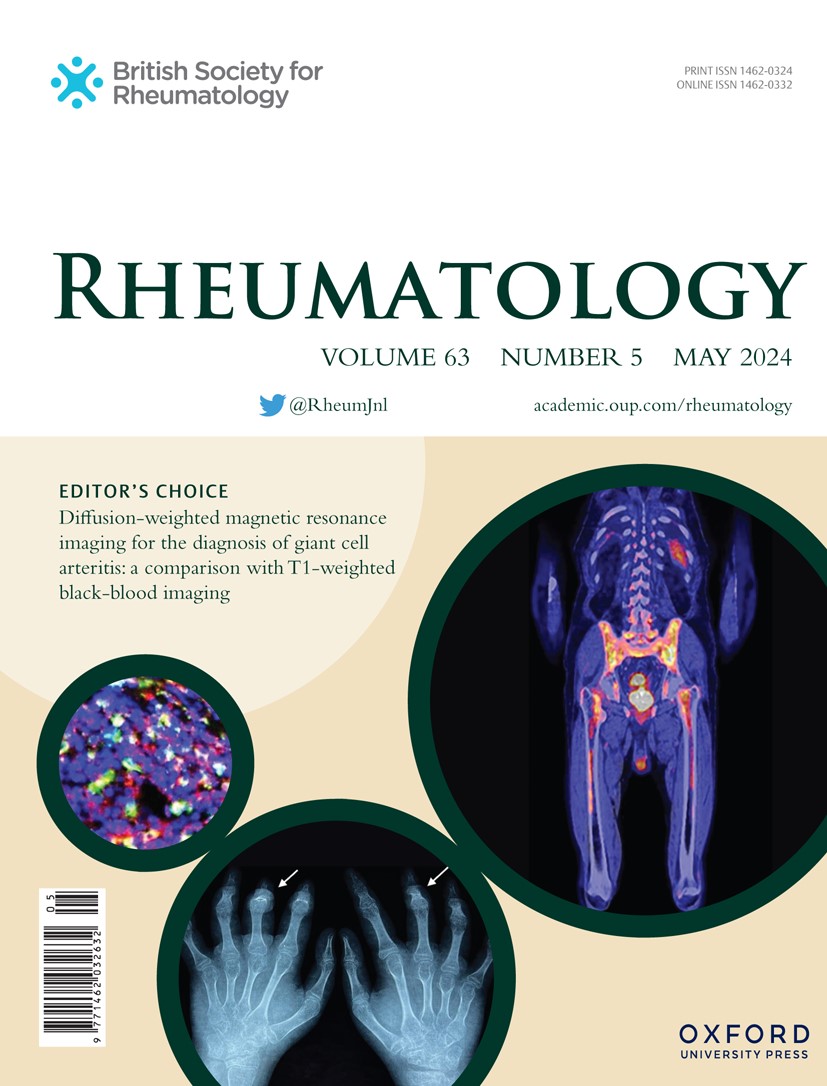糖尿病和心脏病是利妥昔单抗诱导的anca相关血管炎患者急性血小板减少的关键预测因素
IF 4.4
2区 医学
Q1 RHEUMATOLOGY
引用次数: 0
摘要
利妥昔单抗(RTX)是anca相关性血管炎(AAV)的关键治疗药物,但RTX诱导的急性血小板减少症(RIAT)仍然是一个值得关注的问题。我们的目的是评估接受RTX诱导治疗的AAV患者发生RIAT的风险和危险因素。方法纳入日本全国多中心登记的新发显微镜下多血管炎或肉芽肿病合并多血管炎患者接受RTX治疗。RIAT的定义是rtx后28天内血小板计数减少。采用逐步选择的logistic回归方法确定RIAT的危险因素,并建立预测模型。使用c-statistics评估模型性能。结果175例接受RTX治疗的AAV患者中,RIAT发生率为35.4%。糖尿病(比值比[OR] = 4.96)、心脏病(OR = 3.57)、血小板计数低(OR = 1.04 / 104/μL)、血清肌酐升高(OR = 1.44 / 1 mg/dl升高)、低白蛋白(OR = 2.33 / 1 g/dl降低)和高KL-6 (OR = 1.09 / 100 U/ml升高)被认为是显著的预测因素。纳入这些因素的预测模型的c统计量为0.817。结论RIAT是AAV患者RTX诱导的常见并发症,糖尿病和心脏病是其较强的危险因素。我们的预测模型可以对RIAT进行风险评估,使临床医生能够优化治疗策略。本文章由计算机程序翻译,如有差异,请以英文原文为准。
Diabetes mellitus and cardiac disease as key predictors of rituximab-induced acute thrombocytopenia in ANCA-associated vasculitis
Objectives Rituximab (RTX) is a key treatment for ANCA-associated vasculitis (AAV), but RTX-induced acute thrombocytopenia (RIAT) remains a concern. We aimed to evaluate the risk and risk factors of RIAT in patients with AAV undergoing RTX induction therapy. Methods Patients with new-onset microscopic polyangiitis or granulomatosis with polyangiitis who received RTX in a nationwide multicentre registry in Japan were included. RIAT was defined by platelet count reductions within 28 days post-RTX. Risk factors for RIAT were identified by using logistic regression with stepwise selection, and prediction models were developed. Model performance was assessed using c-statistics. Results Among 175 patients with AAV receiving RTX, RIAT occurred in 35.4% of them. Diabetes mellitus (odds ratio [OR] = 4.96), cardiac disease (OR = 3.57), low platelet count (OR = 1.04 per 104/μL decrease), increased serum creatinine (OR = 1.44 per 1 mg/dl increase), low albumin (OR = 2.33 per 1 g/dl decrease), and high KL-6 (OR = 1.09 per 100 U/ml increase) were identified as significant predictors. A predictive model incorporating these factors achieved a C-statistic of 0.817. Conclusion RIAT is a frequent complication of RTX induction in patients with AAV, with diabetes mellitus and cardiac disease being strong risk factors. Our predictive model would enables risk assessment for RIAT, allowing clinicians to optimize treatment strategies.
求助全文
通过发布文献求助,成功后即可免费获取论文全文。
去求助
来源期刊

Rheumatology
医学-风湿病学
CiteScore
9.40
自引率
7.30%
发文量
1091
审稿时长
2 months
期刊介绍:
Rheumatology strives to support research and discovery by publishing the highest quality original scientific papers with a focus on basic, clinical and translational research. The journal’s subject areas cover a wide range of paediatric and adult rheumatological conditions from an international perspective. It is an official journal of the British Society for Rheumatology, published by Oxford University Press.
Rheumatology publishes original articles, reviews, editorials, guidelines, concise reports, meta-analyses, original case reports, clinical vignettes, letters and matters arising from published material. The journal takes pride in serving the global rheumatology community, with a focus on high societal impact in the form of podcasts, videos and extended social media presence, and utilizing metrics such as Altmetric. Keep up to date by following the journal on Twitter @RheumJnl.
 求助内容:
求助内容: 应助结果提醒方式:
应助结果提醒方式:


